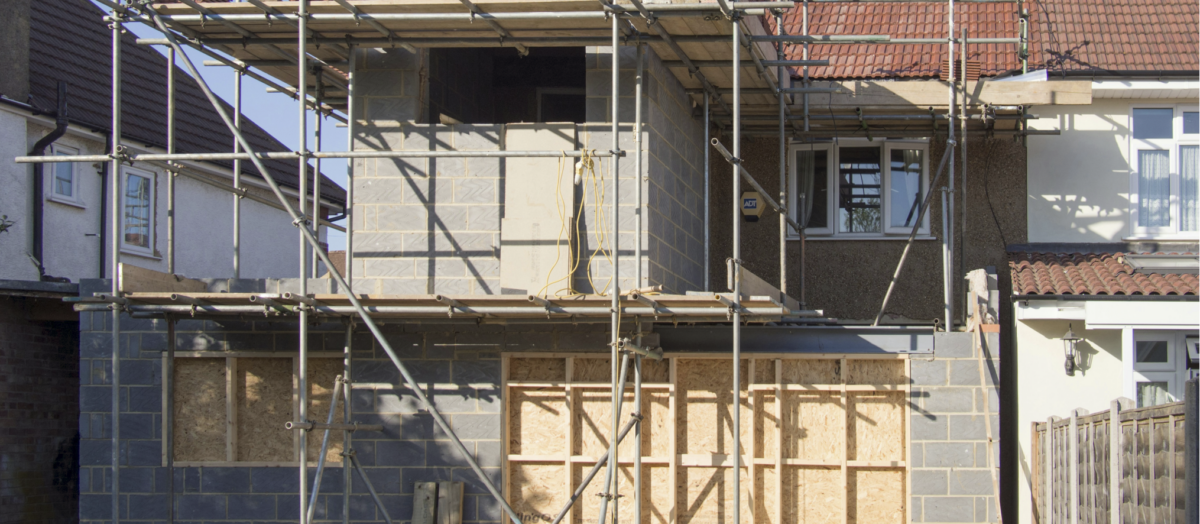How Much Does It Cost To Build An Extension In 2025? A UK Guide
January 30th, 2025
Building an extension is an excellent way to increase living space and add value to your home, particularly when the alternative—moving house—is so expensive. However, costs vary significantly depending on factors such as the type of extension, location, materials used, and the complexity of the project.
In this guide, we break down the average costs of building a ground-floor and double-storey extension to help you understand what to expect when planning your construction project. We provide the average costs by region and also a breakdown of breakdown by project stage and room type.
Building An Extension In The UK
In our calculations, the costs of building an extension are based on the following:
- The roof of the extension is pitched, not flat.
- The extension is constructed out of brick/block, not a timber frame.
Also, the rooms in the calculation for the extension comprise:
- 20m² single-storey rear extension: dining room, utility room, WC.
- 40m² double-storey rear extension: dining room, utility room, WC, two bedrooms, an en-suite bathroom, storage room, small landing.
Start your free trial of BuildPartner today.
Which rooms you choose ultimately affects the overall cost of the extension. For instance, if we were adding a kitchen instead of a dining room, we would need to factor in the cost of fitting a kitchen and the appliances.
Calculations reflect the cost of fitting out the new rooms only. They do not include the remodelling of existing rooms or changes to the layout.
In terms of build specification, our pricing calculator has three options:
- Low spec is a basic finish; e.g. Leyland, Everest, Wickes.
- Mid spec is a standard finish; e.g. Dulux, Hamilton, Slim Line.
- High spec is a high-spec finish; e.g. Farrow & Ball, Fine Line, Siemens.
For the purposes of these extensions, we reviewed the costs for standard specification. Then, for each specification, we’ve provided a range of prices to reflect the varying types of contractors:
- Low benchmark – smaller companies are generally lower cost but less specialised and with low project management function; good for low/mid-spec projects and tight budgets.
- Mid benchmark – medium-sized companies offer a balanced mix of cost-effectiveness and specialisation; good for mid-range projects for effective execution within moderate budgets.
- High benchmark – larger companies generally have a higher cost base but can handle a wide variety of specialist tasks; good for mid/high-spec projects and project management.
Cost of Building A Ground-Floor Extension – Standard Spec
Here’s a table showing the average costs of building a single-storey rear extension for a standard-spec project in the UK:
| Single-Storey Rear Extension | Total Average Build Cost | Average Cost Per Sq Metre | ||||
| Low Benchmark | Mid Benchmark | High Benchmark | Low Benchmark | Mid Benchmark | High Benchmark | |
| East Anglia | £79,067 | £86,255 | £93,443 | £2,636 | £2,875 | £3,115 |
| London | £83,258 | £93,492 | £103,834 | £2,775 | £3,116 | £3,461 |
| Midlands | £76,740 | £83,716 | £90,693 | £2,558 | £2,791 | £3,023 |
| North England | £74,934 | £81,746 | £88,558 | £2,498 | £2,725 | £2,952 |
| Northern Ireland | £77,293 | £84,275 | £91,298 | £2,575 | £2,809 | £3,043 |
| Scotland | £77,334 | £84,364 | £91,395 | £2,578 | £2,812 | £3,046 |
| South East | £83,142 | £92,968 | £102,038 | £2,771 | £3,099 | £3,401 |
| South West | £77,518 | £89,564 | £98,302 | £2,670 | £2,985 | £3,277 |
| Wales | £74,938 | £83,795 | £89,986 | £2,498 | £2,793 | £3,000 |
| Average | £78,247 | £86,686 | £94,394 | £2,618 | £2,890 | £3,146 |
All costs exclude VAT.
Here’s what the data shows for the cost of building a single-storey rear extension to a standard spec:
- It costs 9% more to build an extension in London than in other regions.
- The minimum cost is £74,934, and the maximum cost is £103,834.
- The total average cost is £86,443, or £2,885 per square metre.
Housebuilding Cost Breakdown By Project Stage – London
Here’s an example of the associated costs for the different stages of building an extension for a standard-spec project – when using a mid-benchmark contractor in London:
| Total | £93,492 | 100.0% |
| External wall structure and lining | £14,024 | 15.0% |
| Foundations and substructure | £13,159 | 14.1% |
| Roof structure and coverings | £11,540 | 12.3% |
| Steel and structural supports | £8,133 | 8.7% |
| Floor preparation and finishes | £5,966 | 6.4% |
| Units, worktops and kitchen appliances | £4,457 | 4.8% |
| Heating and cooling | £4,198 | 4.5% |
| External windows and doors | £3,984 | 4.3% |
| Decoration | £3,927 | 4.2% |
| Preliminaries | £3,564 | 3.8% |
| Floor structure and lining | £3,555 | 3.8% |
| Wired appliances | £3,239 | 3.5% |
| Internal wall structure and lining | £2,711 | 2.9% |
| Drainage and pipework | £2,427 | 2.6% |
| Wall preparation and finishes | £2,163 | 2.3% |
| Internal doors and frames | £1,517 | 1.6% |
| Plumbed appliances | £1,373 | 1.5% |
| Demolitions | £1,346 | 1.4% |
| Wiring and fuseboards | £634 | 0.7% |
| Ceiling structure and lining | £581 | 0.6% |
| Ceiling preparation and finishes | £567 | 0.6% |
| Fixtures and fittings | £426 | 0.5% |
Cost Breakdown By Room – London
Here’s a breakdown of the associated costs by room for building a standard-spec extension – when using a mid-benchmark contractor in London:
| Total | £93,492 | 100% |
| Ground Floor Rear Extension with pitched roof | £60,362 | 64.6% |
| Utility | £13,821 | 14.8% |
| Dining room | £10,902 | 11.7% |
| WC | £7,912 | 8.5% |
| P | Preliminaries | £496 | 0.5% |
Cost of Building A Double-Storey Extension – Standard Spec
Here’s a table showing the average costs of building a double-storey extension for a standard-spec project in the UK:
| Double-Storey Rear Extension (Pitched Roof) | Total Average Build Cost | Average Cost Per Sq Metre | ||||
| Low Benchmark | Mid Benchmark | High Benchmark | Low Benchmark | Mid Benchmark | High Benchmark | |
| East Anglia | £131,357 | £143,298 | £155,240 | £2,189 | £2,388 | £2,587 |
| London | £138,434 | £155,344 | £173,574 | £2,307 | £2,589 | £2,893 |
| Midlands | £127,393 | £138,974 | £150,555 | £2,123 | £2,316 | £2,509 |
| North England | £124,191 | £135,481 | £146,771 | £2,070 | £2,258 | £2,446 |
| Northern Ireland | £128,347 | £139,658 | £151,296 | £2,134 | £2,328 | £2,522 |
| Scotland | £128,673 | £140,371 | £152,069 | £2,145 | £2,340 | £2,534 |
| South East | £138,130 | £154,455 | £169,524 | £2,302 | £2,574 | £2,825 |
| South West | £128,668 | £148,454 | £162,937 | £2,213 | £2,474 | £2,716 |
| Wales | £124,572 | £139,295 | £149,616 | £2,076 | £2,322 | £2,494 |
| Average | £129,974 | £143,926 | £156,842 | £2,173 | £2,399 | £2,614 |
All costs exclude VAT.
Here’s what the data shows for the cost of building a double-storey extension to a standard spec:
- The minimum cost is £124,191, and the maximum cost is £173,574.
- The total average cost is £143,581, or £2,395 per square metre.
Average Cost To Build An Extension In 2025
So, how much does it cost to build an extension in the UK? Based on building to a standard specification, you can expect building an extension to cost on average (when using a mid-benchmark contractor):
- Ground-floor rear extension– £86,686, or £2,890 per square metre.
- Double-storey rear extension– £143,926, or £2,399 per square metre.
Please remember that these costs do not include VAT, and there may be other additional costs, such as obtaining planning permission, conducting structural surveys, making unexpected repairs, and completing custom finishes.
Start your free trial with BuildPartner today to get the most accurate estimate of building an extension based on your own dimensions and specifications.
FAQs About Building An Extension In The UK
Here are some frequently asked questions about building extensions in the UK.
What are the different types of extensions?
Common ground-floor extensions include rear, side, double-storey, and wraparound. A rear extension expands the back, while a side extension adds space to the side of the property. A double-storey extension increases space both upstairs and downstairs, and a wraparound extension combines rear and side extensions for a larger, open-plan space.
Do I need planning permission for an extension?
There are many variables to assess to determine if planning permission is needed when building an extension. For example, you need planning permission if your single-storey rear extension is higher than four metres or extends beyond the rear of the “original house” by more than six metres.
In many cases, extensions fall under permitted development rights. Find out more about planning permission in our guide here.
Do I need a Party Wall Agreement?
If your extension affects a shared wall or boundary with a neighbour, the Party Wall Act 1996 requires you to serve notice and potentially obtain their consent.


